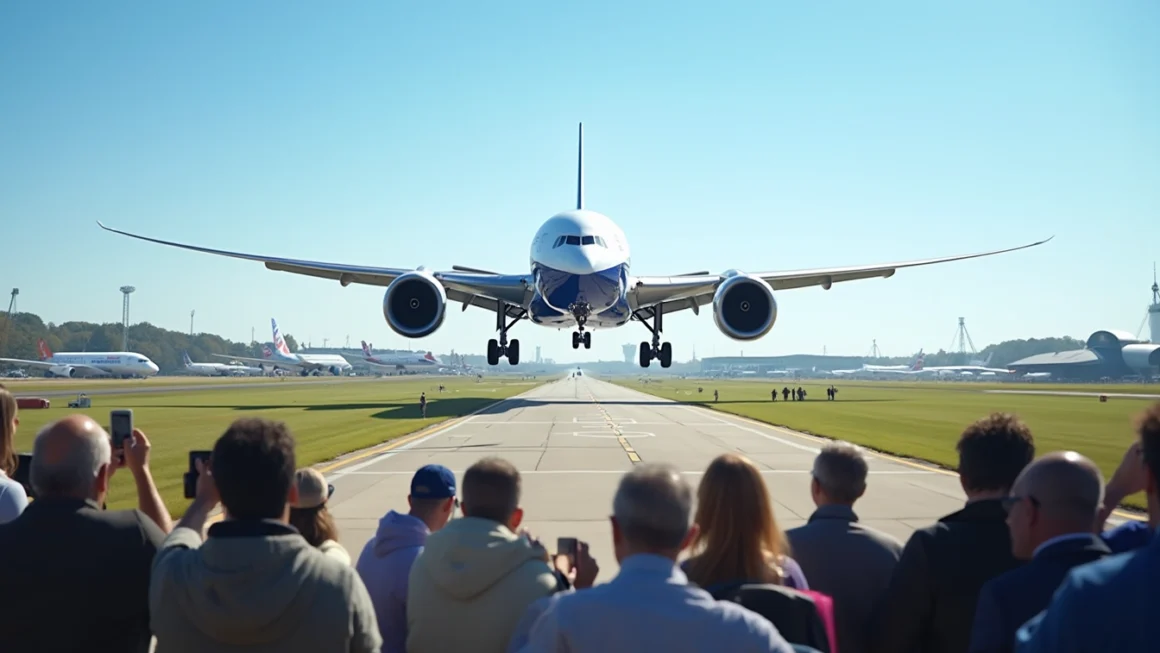The world of aviation has been abuzz with excitement as Boeing’s revolutionary 777-9 passenger jet completed its inaugural transatlantic flight, touching down at the prestigious Farnborough Airshow in the UK. This milestone event marks a significant step forward in the development of next-generation commercial aircraft, promising enhanced efficiency and passenger comfort for future air travel.
A New Era in Aviation
Table of Contents
The Boeing 777-9, also known as the 777X, represents the latest advancement in twin-engine wide-body aircraft design. With its impressive size and cutting-edge technology, this aircraft is set to redefine long-haul travel. The successful transatlantic journey showcases the aircraft’s capabilities and brings it one step closer to commercial service.
Key Features of the Boeing 777-9
Innovative Wing Design
One of the most striking features of the 777-9 is its folding wingtips. This unique design allows the aircraft to maximize aerodynamic efficiency during flight while still being able to fit into standard airport gates. The folding mechanism reduces the wingspan from 235 feet to 212 feet, providing flexibility in airport operations.
Enhanced Fuel Efficiency
The 777-9 boasts improved fuel efficiency, thanks to its advanced aerodynamics and new GE9X engines. This increased efficiency not only reduces operating costs for airlines but also contributes to lower carbon emissions, aligning with the industry’s sustainability goals.
Spacious and Comfortable Cabin
Passengers can look forward to a more comfortable travel experience with the 777-9’s wider cabin. The aircraft’s design allows for wider seats and aisles, creating a more spacious feel and enhancing overall passenger comfort on long-haul flights.
The Journey to Farnborough
The flight from Seattle to Farnborough was not just a demonstration of the aircraft’s range and capabilities; it also served as a crucial test for various systems and components. The successful completion of this journey brings Boeing closer to obtaining the necessary certifications for commercial operations.
Industry Impact and Future Prospects
The arrival of the 777-9 at Farnborough Airshow has generated significant interest among industry professionals and aviation enthusiasts alike. Airlines are keenly observing the aircraft’s performance, as it promises to offer a competitive edge in the long-haul market.
While the development of the 777X program has faced delays, partly due to the global pandemic and regulatory scrutiny, the successful transatlantic flight represents a positive step forward. Boeing aims to deliver the first 777-9 to launch customer Emirates in 2025, with other major carriers also placing orders for this next-generation aircraft.
Challenges and Opportunities
Despite the excitement surrounding the 777-9, Boeing faces challenges in the current aviation landscape. The company must navigate a competitive market, regulatory requirements, and changing airline needs in a post-pandemic world. However, the 777-9’s advanced features and efficiency improvements position it well to meet future demands for long-haul travel.
The Road Ahead
As the Boeing 777-9 continues its testing and certification process, the aviation industry watches with anticipation. The success of this aircraft could shape the future of long-haul travel, offering airlines a powerful tool to optimize their operations and provide enhanced passenger experiences.
The journey of the 777-9 from concept to reality showcases the ongoing innovation in aerospace technology. As we look to the future of air travel, it’s clear that efficiency, sustainability, and passenger comfort will continue to drive advancements in aircraft design. For those interested in staying updated on the latest trends in technology and automation across various industries, exploring automation solutions can provide valuable insights into how these advancements are reshaping our world beyond aviation.
Conclusion
The arrival of Boeing’s 777-9 at Farnborough Airshow marks a significant milestone in aviation history. As this next-generation aircraft moves closer to commercial service, it promises to bring new levels of efficiency and comfort to long-haul travel. The successful transatlantic flight not only demonstrates the 777-9’s capabilities but also signals the continuing evolution of air travel in the 21st century. As we look to the skies, the future of aviation appears brighter and more innovative than ever before.




